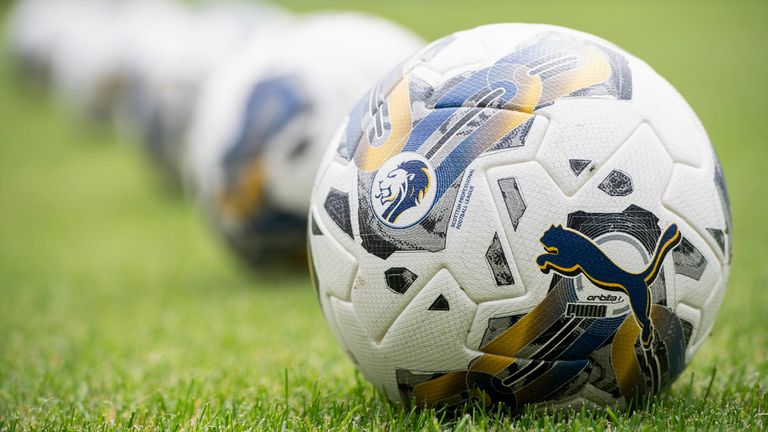Lewis Stevenson and Paul Hanlon both have over 550 appearances for Hibernian; they are out of contract at Easter Road in the summer

Image: Paul Hanlon (L) and Lewis Stevenson will leave Hibs at the end of the season
Hibernian duo Lewis Stevenson and Paul Hanlon will leave Easter Road at the end of the summer, after almost two decades.
The pair, who have played more than 1,100 games combined for the Hibees, are out of contract in the summer.
Both came through the Hibernian FC Academy, with Stevenson making his debut in 2005 and Hanlon following on in 2008.
- Stream Scottish Premiership and more with NOW
- Get Sky Sports | Download the Sky Sports App
- Free-to-watch Scottish Premiership highlights
- How to book Fury vs Usyk on Sky Sports Box Office
Twitter This content is provided by Twitter, which may be using cookies and other technologies. To show you this content, we need your permission to use cookies. You can use the buttons below to amend your preferences to enable Twitter cookies or to allow those cookies just once. You can change your settings at any time via the Privacy Options. Unfortunately we have been unable to verify if you have consented to Twitter cookies. To view this content you can use the button below to allow Twitter cookies for this session only. Enable Cookies Allow Cookies Once
Stevenson was just 19 when he picked up a man-of-the-match performance as they beat Kilmarnock 5-1 at Hampden Park to lift the Scottish League Cup in 2007.
In the 2015/16 campaign, the pair played their part in ending the club’s 114-year wait to lift the Scottish Cup.
Hanlon was officially named club captain in the summer of 2021, while Stevenson became the club’s all-time record league appearance holder in February 2023.
Stevenson has featured 599 times for the Leith club, with Hanlon close behind on 562 appearances.

Image: Lewis Stevenson and Paul Hanlon were part of Hibs’ Scottish Cup-winning side
The Gordon Family commented: “We’d like to begin by thanking Paul and Lewis for everything they have done at Hibernian FC. What they have achieved at the club is absolutely magnificent and their names will forever be written in the club’s history.
“They will always be considered among the greats at Hibernian FC, which is down to the tremendous roles they’ve played both on and off the pitch. They will always be friends of the club.
“Our final home game against Motherwell will give us a chance to bid an emotional farewell to both Paul and Lewis, and give them the send-off they deserve.”
The club will hold a special tribute to the duo after their final home game of the season against Motherwell on May 15.
Scottish Premiership and SWPL on Sky Sports

Sky Sports – This season up to 48 cinch Premiership games will be available across Sky Sports’ flagship channels, including Sky Sports Football and Sky Sports Main Event, plus at least five SWPL matches. From 2024/25, up to 60 cinch Premiership will be live on Sky Sports, in addition to the SWPL.
Sky Sports News – Running 24 hours a day, seven days a week, Scottish football fans can enjoy Sky Sports News’ (channel 409) rolling editorial coverage of the cinch Premiership and SWPL throughout the season.
Sky Sports Digital – Follow all the latest from Scottish football across SkySports.com and app, including exclusive features and interviews, plus dedicated live blog coverage, in-game clips from matches live on Sky Sports and free highlights.
Sky Sports Social – Alongside coverage and visibility for the league across all Sky Sports’ main social media channels, the bespoke X page @ScotlandSky will continue to be the home of all Scottish football content on Sky Sports.
Highlights show – Tune in for a dedicated round-up from the cinch Premiership every week on Sky Sports Football.
Sky Sports is the home of domestic football in the UK and Ireland, with action from the Scottish Premiership, Scottish Women’s Premier League, Premier League, WSL, EFL, and more.
Ad content | Stream Sky Sports on NOW

Image: Watch Scottish Premiership, Premier League, F1, Tennis and more on Sky Sports with NOW
Stream Sky Sports live with no contract on a Month or Day membership on NOW. Instant access to live action from the Scottish Premiership, Premier League, EFL, F1 and so much more.
Find out more here…
Get Sky Sports on WhatsApp!

You can now start receiving messages and alerts for the latest breaking sports news, analysis, in-depth features and videos from our dedicated WhatsApp channel!
Find out more here.
Sourse: skysports.com